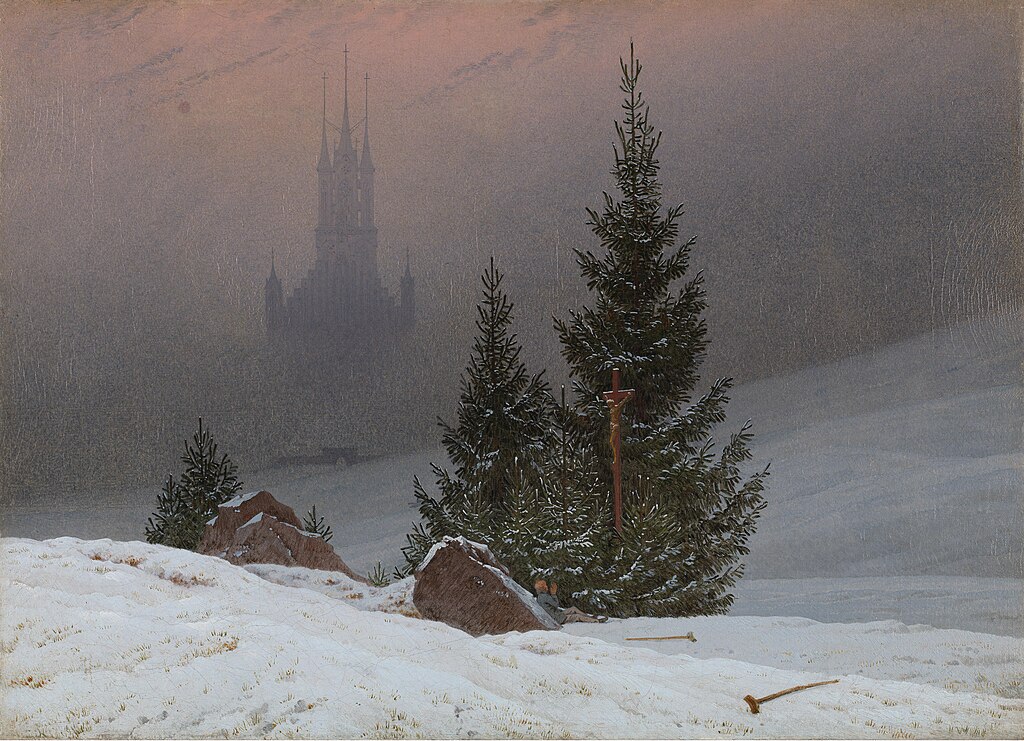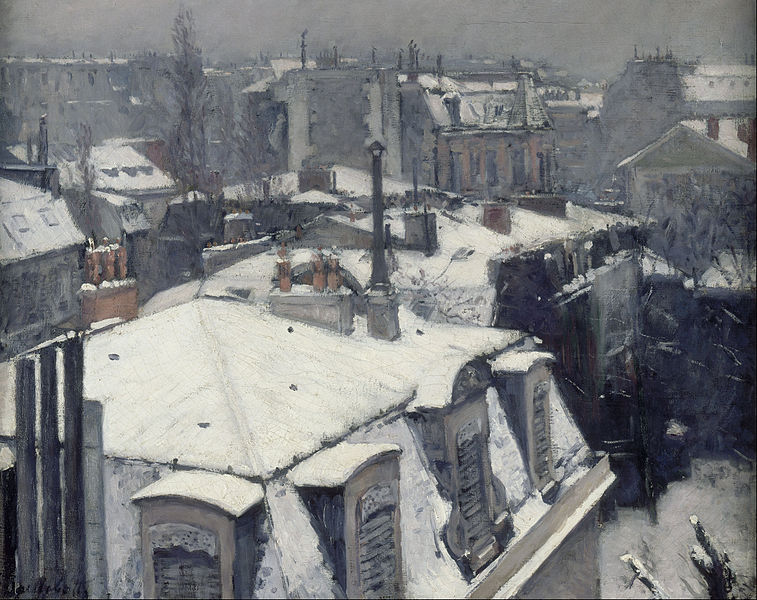In the Northern Hemisphere the first day of winter in 2023 is December 21. Also known as the Winter Solstice, the day has the fewest hours of sunlight than any other day of the year and of course the longest night. Winter brings snow, and snow scenes were rarely attempted by artists until Dutch painters did so in the17th Century. The Dutch were the first Europeans to be free of a king, and they were Protestants. The people were educated and prosperous members of the middle-class. They purchased art for their homes. Artists developed new subject matter: landscape, still-life, and genre. In a thriving art market, patrons visited artists’ studios to select work from a range of subject matter.
“Winter Landscape with Windmill” (1670-75) (14.6”x18’’) is by Jacob Van Ruisdael (1628-1682), one of the preeminent landscape painters of the Dutch Golden Age (c.1588-1672). Of the hundreds of paintings he made, only 25 to 30 were winter scenes. Winter landscapes used mostly black and white paint, making it a challenge to create all the elements in the scene. Van Ruisdael effectively created a chilly, snowy day. The dark sky has touches of blue-gray clouds hanging over the land and people. A windmill and a house are painted with a touch of beige to suggest the wood and stone. A single male figure, shoulders hunched against the cold, walks toward the house. A small number of figures walk and sled on the distant frozen river. The river bank, pier, and frozen plants on the shore can be seen. Three geese look for food and a drink of water from the nearly frozen pond.
Casper David Friederich (1774-1840), a German Romantic painter, describes winter in a different manner in “Winter Landscape” (1811) (13’’x18’’). Snow covers the ground, and a cold mist rises from the earth. The composition of diagonals leads the viewer’s eye through the composition. A single brown crutch is seen in the foreground at the right, and another crutch a little farther back. The brown crutches form a diagonal line, directing the eye to the two peaked brown rocks. The banks of snow form sweeping diagonals as the landscape recedes.
The sky is just beginning to show the pink glow of sunrise in the background. The shape of the tallest tree repeats the shape of the spires of a Gothic church just visible through the mist. They almost touch the top of the painting. A bit lower in the composition, the second tree and the lower towers of the church are parallel to one another. The space between the two rocks leads the viewer’s eye to the church.
A red-haired man in a gray coat rests against the largest brown rock in front of the three evergreen trees. At the center of the largest tree is a brown wood crucifixion, revealing the religious context of the landscape. The man has walked through the snow on his crutches, abandoning them when he takes refuge at the rock. He looks up at the crucifixion, his hands raised in prayer. Interpretations of this scene vary. If the man is dying, he may be at peace. If he will live, he may have found a new beginning. Evergreen trees symbolize renewal and eternal life.
“A man on horseback in the snow” (1840-42) (6’’x8.25’’) is a Ukiyo-e woodcut by the famous Japanese artist Hiroshige (1797-1855). It is number 38 from his series 53 Stations of the Tokaido Road. The Tokaido Road (eastern sea route) is the main road from the capital of Kyoto to Edo (present day Tokyo), the capital of the Tokugawa Shogunate. There are 53 post stations along the road. Hiroshige traveled the road and created wood cuts to illustrate the special aspects of each station during the season when he visited.
Black, red, yellow, and blue inks are used. The white paper represents the snow. Black outlines shape the trees, figures, and houses of a village buried in snow. Red is the second most important color, and Hiroshige used it to represent bark on the trees, the horse, the legs of the man in front of the rider, and the window screens on the houses. The placement of the red draws the viewer’s eye around the composition. He also used red and blue at the top of the woodcut and as a background for the landscape and the village. The red banner at the top right is Hiroshige’s seal.
The man on horseback wears a hat and cloak to keep him warm; all is covered with snow. His horse is loaded with two packs colored a very pale yellow. Hiroshige uses blue on the horse’s pack and the farthest figure walking through the town. The horse’s legs and the legs of the man leading the horse are buried in the snow. Below the hill, another figure walking into town is outlined in black. The snowflakes, or stars, are arranged in a pattern of white dots and appear only in the background sky. The 53 Stations of the Tokaido Road was immediately popular and responsible for making Hiroshige one of the world’s most famous Ukiyo-e artists.
A series of volcanic eruptions in 1809 caused a major period of cold weather and snow across Europe. Impressionist artists, interested in depicting scenes in all seasons, attempted to capture effets de neige (the effects of snow). Impressionists were influenced by Japanese woodcuts that often depicted falling snow. Among the Impressionists who painted series of snow effect paintings was Claude Monet (1840-1926). “The Magpie” (1869) (35’’x51’’) is one of Monet’s 140 snow paintings, and it is the largest. It was painted while Monet, his girlfriend Camille Doncieux, and their new-born son were comfortably housed in Etretat, Normandy.
Monet experimented with the new knowledge that sunlight was composed of the colors of the rainbow: purple, blue, green, yellow, orange, and red. Sun shining on a white surface such as snow created shadows containing those colors, not black. Objects in nature can be black and white, but the sun shining on them produces only the colors of the rainbow. Monet depicts a black and brown wood wattle fence stretching across the center of the composition, and he used black and brown for the tree trunks. All are covered with white snow. However, the shadows on the snow are blue. The houses in the background and the wood gate at the left are light beige, a mixture of blue and orange. Brown is the combination of two complementary colors; here they are blue and orange. Tiny spots of the beige also create texture on the surface of the snow. Scattered throughout the composition are areas of orange, visible in the two chimneys, under the roof line, and as accents on the trees and the gate.
Monet added the single figures of the black magpie with the blue belly. The curved shape of the magpie is repeated in the black branches of the large tree at the right. Both shapes bend toward each other. Everything is covered with snow, and the sun shines bright and clear.
From the countryside to the roof tops of Montmartre in Paris, the Impressionists were challenging themselves to paint a snow effect. Gustave Caillebotte (1848-1894), another French Impressionist, painted “Rooftops in the Snow (snow effect)” (1878) (25”x32’’). Caillebotte uses color in shadows sparingly, and he bridges the more traditional realism with this new understanding. The white snow is applied with thick paint, effectively creating the heaviness of the snow as it overhangs the roofs and windows. Some gray shadows are lightly tinted with blue, most obvious on the sides of the near windows. The slight tint of orange also can be seen on the fronts of the near window, and on the chimneys and fronts of several of the distant houses.
Baron Haussmann was commissioned from 1853 to 1870 by Napoleon III to redesign Paris to be more spacious and hygienic. Overcrowded neighborhoods were demolished, and streets were straightened and widened. Houses were built according to Haussmann’s design with dormer windows and mansard roofs to bring more light into the interior. The houses were built of Lutetian limestone, also known as Paris stone. It is described as a “warm, elusive, cream-grey stone.” (Wikipedia)
Caillebotte became famous for his cityscapes. The remodeled Paris of 1870 still exists today. Caillebotte was one of the few artists who depicted scenes of rooftops. In the 4th Impressionist Exhibition (1879) he showed 25 paintings including two of rooftops; one was “Rooftops in the Snow.”
Monet and Caillebotte were close friends, and beside their love of painting, were gardeners. They frequently visited each other and discussed gardening. Caillebotte died at the age of 46. Monet wrote about his friend: “If he had lived instead of dying prematurely, he would have enjoyed the same upturn in fortunes as we did, for he was full of talent. He was as gifted as he was conscientious and when we lost him, he was still at the beginning of his career.”
Beverly Hall Smith was a professor of art history for 40 years. Since retiring with her husband Kurt to Chestertown in 2014, she has taught art history classes at WC-ALL. She is also an artist whose work is sometimes in exhibitions at Chestertown RiverArts and she paints sets for the Garfield Center for the Arts.








Write a Letter to the Editor on this Article
We encourage readers to offer their point of view on this article by submitting the following form. Editing is sometimes necessary and is done at the discretion of the editorial staff.